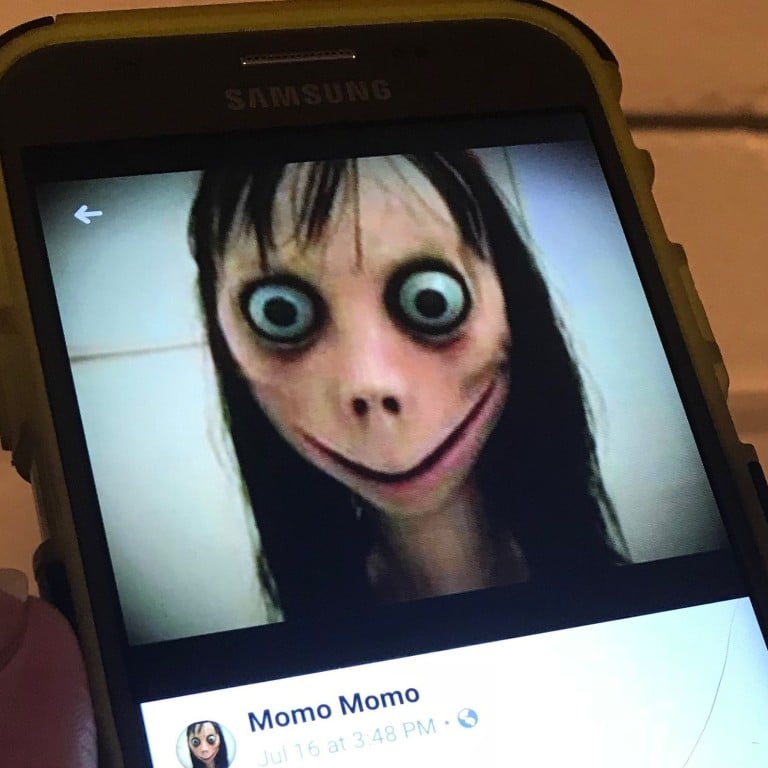
‘Momo challenge’ fears in Hong Kong, as school principal warns parents over YouTube scare
- The creepy online phenomenon has been linked with self-harm and even suicide
- But others say it is just a hoax
Parents and teachers have raised concerns over their children coming across distressing images or videos of “Momo” – a creepy female fictional character – and worries that such content, which has gone viral overseas, could spread in Hong Kong schools.
The images of Momo feature a grinning, gaunt, pale woman with bulging eyes and matted black hair. Warnings about the “Momo challenge” have recently emerged on social media saying that parents are worried about alleged videos of the character on YouTube, encouraging children to self-harm or do dangerous tasks, such as turning on the stove without telling their parents.
One mother in the Philippines reportedly attributed her 11-year-old son’s suicide to the challenge. But police there said there was no evidence of a link.
Several international media outlets reported that the challenge was a hoax, and YouTube declared there was no evidence of such videos on their platform.

The content prompted a primary school in Hong Kong to send a letter to parents, saying it was aware of such videos making the rounds among schoolchildren locally on different media platforms.
“The school would like to remind parents to closely monitor how their children use the internet and social media, to avoid other students being affected,” Fielie Fung Yiu-cheung, principal of Baptist Rainbow Primary School, wrote in his letter.
Fung said only one pupil had told a teacher that he or she had seen the character on their mobile phone after the letter was sent out on Friday.
Fung said his own nine-year-old daughter, who studies at a different school, was frightened by the image.
“After she saw the photo, she told me she was really scared and that she didn’t want to sleep alone. She said she was scared it would jump out at her, like a ghost,” Fung told the Post.
His daughter also described how one of her classmates taped their iPad microphone, warning others that it was because “Momo would be able to hear you talking”.
Videos encouraging harmful and dangerous challenges are clearly against our policies, the Momo challenge included
“It shows that kids their age are not able to differentiate between what’s real and not,” he said.
A parent also complained on a popular discussion thread on an online forum that her daughter watched a video showing the character.
“My daughter saw this thing on YouTube two days ago ... she was watching some cartoon. After a while, as I was sitting next to her, I saw [that thing on the screen]. I thought she had clicked on some horror cartoons,” wrote user ChingyanPang.
In a statement, YouTube denied there was any evidence of videos promoting any challenge on their site.
“Videos encouraging harmful and dangerous challenges are clearly against our policies, the Momo challenge included,” it said.
However, it noted that there had been screenshots of videos and thumbnails with the character, as it is not against its policy for creators to discuss, report or educate viewers on the topic.
It added that the image had been banned from the YouTube Kids app, a platform designed for people under 13 years old, with curated “child-friendly” content, filters and parental controls.
A clinical psychologist said children, especially those aged below six, could feel distressed after seeing disturbing images, as they are not yet at a stage where they can easily differentiate between what is real and what is an illusion, and could imagine that such a character could harm them.
“For those who have a weak self-defence mechanism, they may not be able to find suitable ways to handle their emotions,” said Dr Amos Cheung Chuen-yih, who is also the president of the Hong Kong Psychological Society.
Cheung said it was normal if such emotions lasted for two to three days, but parents should consider seeking help if children suffer from certain symptoms – such as nightmares, or wanting parents to accompany them to the toilet or to bed – for more than a week or two.
The most important point for parents to note, Cheung said, was to not berate their children or tell them the character was fake.
“If a child is distressed and you tell them that it’s fake, they may suddenly feel stupid. Instead, what parents should say is: ‘Dad and Mum are here, you are safe, you can tell me what’s worrying you’,” Cheung said.
Angie Shum Kwan-yu, a clinical psychologist and training consultant at the Centre for Suicide Research and Prevention at the University of Hong Kong, said when children see online messages about a challenge involving self-harm or suicide, they could be frightened and some could follow the game out of curiosity.
Shum said parents should monitor how their children use the internet.
“Children may watch it because they are curious about it. After watching, there may be some words that frightened them, they may not know how to talk to their parents. So the key is parents should take care of the emotional changes of their children,” she said.

